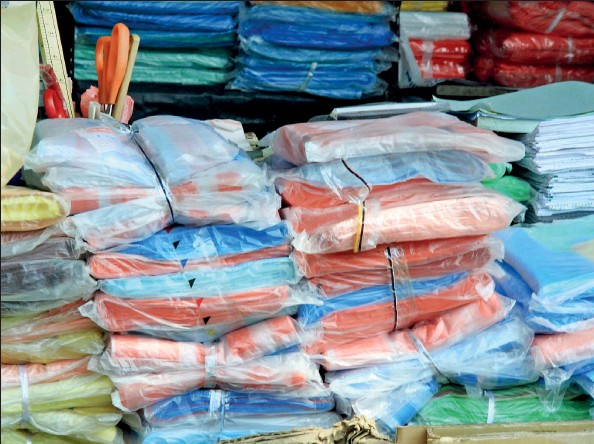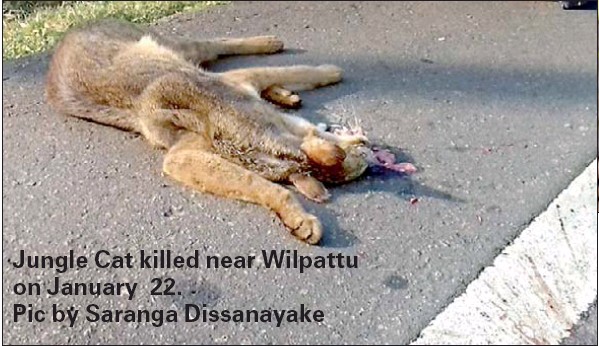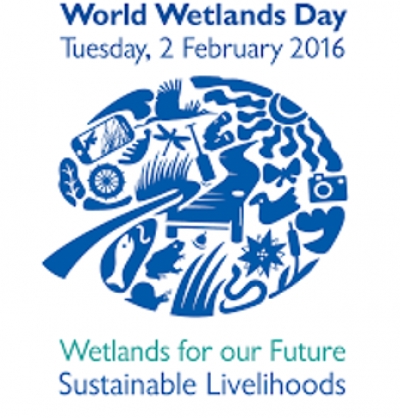
Polythene baddies hammered from tomorrow-31 Jan 2016 Sunday Times (Sri Lanka)
By Malaka Rodrigo
Any form of polythene or plastic takes hundreds of years to decay, polluting the environment, but thinner polythene is more evil as it cannot be recycled. Burning it causes the emission of poisonous gases such as dioxin, so such polythene ends up in garbage dumps.
The Central Environment Authority (CEA) will from next month systematically begin raiding the manufacturers and sellers that do not comply with the ban on polythene less than 20 microns in thickness.
Big demand: A shop that sells only ‘sili sili’ bags in Pettah. Pix by Indika Handuwala“In January, we made some raids and those found guilty had been given chance to adjust to alternatives. But from February onwards, we will take legal action against those who do not comply,” a CEA spokesman warned.
The manufacture, sale or use of polythene less than 20 microns in thickness was banned from 2007 under the National Environment Act under the directive of President Maithripala Sirisena while he was the minister of environment but the law has until now not been properly implemented.
The thickness of polythene sheets is measured in microns – a unit resembling 0.001 millimeter. These thinner polythene sheets are mostly used in shopping bags or “sili sili bags”, lunch sheets and other packaging materials.
Any form of polythene or plastic takes hundreds of years to decay, polluting the environment, but thinner polythene is more evil as it cannot be recycled. Burning it causes the emission of poisonous gases such as dioxin, so such polythene ends up in garbage dumps.
Dumped bags clog the drainage system, creating floods. Animals such as cattle also feed on polythene bags found on rubbish heaps and become ill or die.
The water collected in these disposed bags and wrappers can collect rainwater, making breeding grounds for mosquitoes that spread diseases such as dengue. Polythene dumped in waterways finds its way into the ocean, choking and killing marine life.
According to a survey conducted by the Environment Ministry 72 per cent of villagers and 49 per cent of people in urban areas in the Western Province use polythene lunch sheets.
In total, about 500,000 metric tonnes of polythene and plastics are imported into Sri Lanka with 70 per cent of this going into domestic use while 30 per cent is used in export-related industry.
The positive side is that about 40 per cent of the plastics and thicker polythene is being recycled. The CEA currently has six recycling plants in operation and two more awaiting commissioning. About 160 firms involved in plastic recycling are registered with the CEA and this number is expected to increase.
Worryingly, 60 per cent of the plastic and polythene used domestically ends up in garbage.
The authorities hope the ban on thin polythene will be effective. In Bangladesh, which banned the use of polythene bags in early 2000, media reports say polythene is making an illegal comeback.
A change in consumer attitude is key to the success of the strategy. Experts recommend the widespread teaching of the 3R principles: Refuse, Reuse and Recycle. As consumers, we all have the power to refuse a polythene bag when it is not necessary and we can carry reusable bags.

Wildcats in the shadow of the leopard also vanishing- 7 Feb 2016 Sunday Times
By Malaka Rodrigo
The death of a full-grown jungle cat at the hands of a speeding motorist late last month highlights the worrying fate of these animals while public concerns focus on fatalities of their more magnificent cousin, the leopard.
Photographs of the dead jungle cat lying stretched across a road near Wilpattu were published on social media by a saddened local motorist, Saranga Dissanayake who said he had also seen a fishing cat killed on the same stretch a few months ago.
Sri Lanka is home to four species of wildcat: leopard (Panthera pardus – kotiya diviya), fishing cat (Prionailurus viverrinus – handun diviya), jungle cat (Felis chaus – wal balala) and rusty-spotted Cat (Prionailurus rubiginosus – Kola diviya).
The killing of a leopard last August on a road in Yala sparked much attention but other wildcats sharing the same plight mostly go unnoticed.
According to the International Union for the Conservation of Nature (IUCN) Red List of threatened species the jungle cat is “near threatened” while the other three species are “endangered” indicating the need of urgent action for their conservation. Other than road accidents, Sri Lankan wildcats face death through wire traps, poisoning and habitat destruction.
Sadly, insufficient research exists to identify the level of these threats, the ecology of the individual species and species distribution, factors that are the basis of any conservation action.
The first Symposium of Wild Cats of South Asia, past and present, organised by the Sri Lanka Wildlife and Nature Protection Society (WNPS) with support from the Mohamed bin Zayed Species Conservation Fund and the IUCN last November provided a forum for Sri Lankan and foreign researchers to forge links and identify directions for wildcat research.
The researchers agreed knowledge was lacking on small cats compared to leopards, especially rusty-spotted cats and jungle cats.
WNPS President Professor Lakdas Fernando said a wildcat working group has now been established. “Understanding conservation priorities will be the first step toward saving these species. Hopefully we can meet in two years for another symposium where we can take solid conservation action for Sri Lanka’s wildcats,” Professor Fernando said.
The November symposium was a good platform for many young researchers such as Anya Ratnayake who study wildcats. Ms Ratnayake, who spearheads a fishing cat study project by the Environmental Foundation Limited, said she had found fishing cats living in areas adjacent to dense human habitation to be active at day and night. Researchers tracked individual fishing cats fitted with GPS collars.
“Based on the distribution and movement patterns of fishing cats in urban habitats we proposed the creation of urban bioparks for biodiversity conservation and green areas for urban wildlife,” the young researcher said, adding that integration of these zones was more important than ever with the proposed megapolis development plans across the Western Province.
Ashan Thudugala, a young researcher following fishing cats in the hill country, spoke out on threats posed by speeding motorists to these cats, as well as poaching and poisoning.
It is heartening to see that young researchers are going beyond paperwork to protect wildcat populations. Ashan Thudugala, for example, conducts awareness programs and youth camps for schoolchildren and local villagers in areas where wildcat mortality is high. Fishing cat roadsigns have been placed at danger spots on roads.
A leading authority, Dr. Jim Sanderson of the Small Wildcat Conservation Foundation, specially praised the work of the young researchers of Sri Lanka in studying smaller wildcats.
The conservation of leopards is still a key focus. In recently released symposium papers, researchers Andrew Kittle and Anjali Watson explain that the change of land use patterns in many areas poses a threat to Sri Lanka’s apex predator.
Dr. Andrew Kittle particularly highlighted the threats faced by hill country leopards. “Ongoing distribution mapping indicates that leopards occupy small, isolated forest patches with little or no protection. Many of these occur in Sri Lanka’s central highlands where a high human population density, heavily-fragmented landscape mosaic and lack of large, contiguous protected areas means leopards here are potentially highly vulnerable,” he states.

Ceylon Chamber supports Sustainable Energy Authority to promote ‘Biomass Energy Production and Modern Bio Technologies’-7 Feb 2016 Sunday Times
Ceylon Chamber of Commerce, the country’s premier business chamber will conduct a seminar on Sustainable Biomass Energy Production and Modern Bio Technologies in a bid to help the government’s drive towards increasing the production of biomass based energy sources in the Island,a media release issued by the CCC said.
The seminar, which will be held during the second week of February, 2016 at the Auditorium of the Ceylon Chamber of Commerce, will focus on educating the stakeholders on an ongoing GEF (Global Environment Facility) Funded project which is being implemented by the Sri Lanka Sustainable Energy Authority, with the support of the FAO and UNDP.
The project aims to promote ‘Sustainable Biomass Energy Production and Modern Bio-Energy Technologies’ with the goal of reducing greenhouse gas emissions from the use of fossil fuel for thermal energy generation in Sri Lanka’s industrial sector.
The ongoing GEF funded project, authorities expect will help remove barriers to the realization of sustainable biomass plantation, increase the market share of biomass energy generation mix and adoption of improved biomass-based energy technologies in Sri Lanka.
It focuses on four key areas such as, ‘Policy-institutional support for effective implementation’; ‘Barrier removal for sustainable fuel wood production,’ ‘Enabling environment for fuel wood suppliers’; and also ‘Wood-based energy technology development’.

Lanka observing World Wetlands Day today- Sunday Times, 2 February 2016
 Sri Lanka has planned national and regional events to mark World Wetlands Day, which falls on February 2nd. The Daily Star reported that the date marks the 1971 adoption of the Ramsar Convention, an intergovernmental treaty that helps protect wetlands, reached in Ramsar, Iran.
Sri Lanka has planned national and regional events to mark World Wetlands Day, which falls on February 2nd. The Daily Star reported that the date marks the 1971 adoption of the Ramsar Convention, an intergovernmental treaty that helps protect wetlands, reached in Ramsar, Iran.
In Sri Lanka, the national ceremony to mark the World Wetlands Day will be held at the premises of Mangrove Conservation Project of the Sudeesa (formerly known as Small Fishers Federation of Lanka) at Chilaw today.
President Maithripala Sirisena will grace the occasion as the chief guest. The theme for this year is ‘Let’s protect wetlands for the future for a sustainable living’.
Regionally, European Union funded Solid Waste Management for Batticaloa Programme implemented by the United Nations Office for Project Services (UNOPS) will conduct a clean-up campaign today. Awareness on the wetland cleanliness will be provided to those who pass by the Batticaloa lagoon.(ANI)




